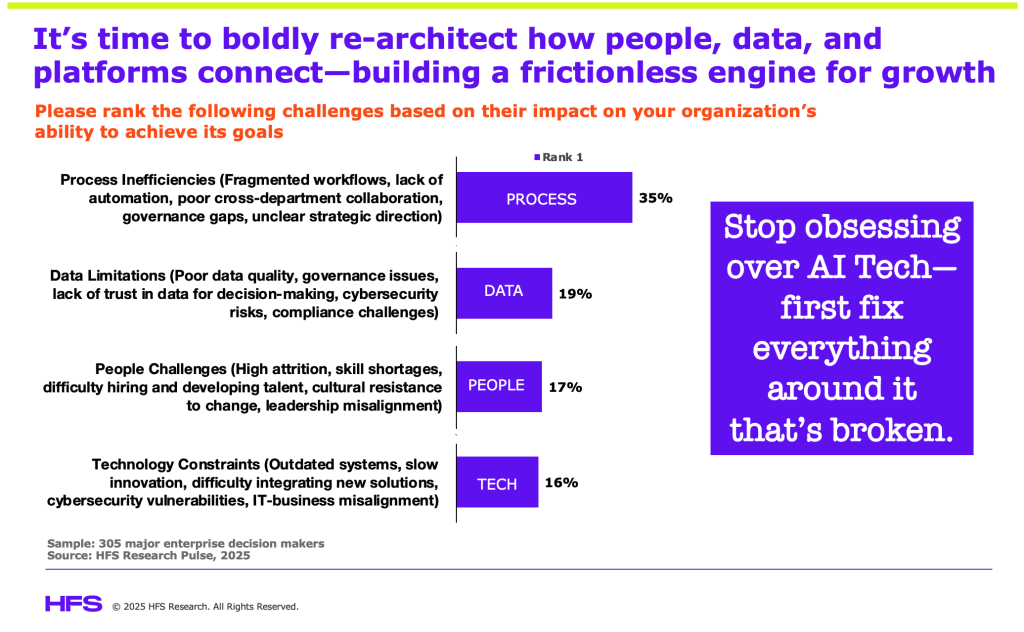
Agentic AI will revolutionize individual productivity within 18 months, but your enterprise transformation is about to hit a wall. While ChatGPT Agent, Google’s Project Mariner, and Perplexity’s Comet promise AI that books reservations and manages workflows autonomously, the gap between what works for individuals and what scales in enterprises is massive.
Here’s why individuals will win and enterprises will stumble, and what you need to do about it now.
Individuals will adopt agentic AI 10x faster than enterprises because the barriers are non-existent
For knowledge workers, deploying agentic AI is trivial. You connect the agent to your Gmail, calendar, and OpenTable account, and you’re done. If it screws up your dinner reservation, you fix it. If it sends a weird email, you apologize. The experimentation is cheap, the stakes are manageable, and there’s no IT department blocking your access.
This is why productivity-obsessed individuals are already automating routine tasks like booking travel, summarizing documents, and managing follow-ups. The technology doesn’t need to be perfect, it just needs to save more time than it costs. And for workers drowning in administrative overhead, that bar is surprisingly low.
Your best employees are already using these tools. They’re becoming AI-augmented superhumans while your enterprise is still forming committees to discuss governance frameworks.
Your enterprise isn’t ready because it was never designed for autonomous AI
Deploying agentic AI in an enterprise isn’t a software implementation. It’s a complete business reinvention. Consider what you actually need:
Unified data access across siloed systems. Your customer data lives in Salesforce, your financial data in SAP, your operational data in ServiceNow. An AI agent needs to see what a human employee sees across all these systems simultaneously. Most enterprises don’t have this foundation.
Standardized workflows that can be automated. Your business processes are tribal knowledge passed down through email chains and hallway conversations. Before an AI can handle expense reports or customer inquiries autonomously, you need to document, standardize, and make machine-readable every workflow. That’s a multi-year project.
Security protocols that allow AI to act on behalf of employees. Your compliance team is still debating whether employees should paste confidential information into ChatGPT. Now imagine explaining that an AI agent will log into enterprise systems, move money, sign contracts, and communicate with customers. The organizational resistance isn’t technical. It’s cultural and political.
Governance frameworks for when things go wrong. Who’s liable when the agent makes a mistake? How do you audit AI decisions? What happens when an agent acts on outdated information? You need trust infrastructure that doesn’t exist yet.
The transcript you’re reading admits the uncomfortable truth: “everybody is trying to build them, but right now they don’t actually work that well.” Individual users will tolerate imperfection and iterate quickly. Enterprises won’t and can’t.
The productivity gap will create winners and losers faster than you think
We’re entering a period where individual productivity and enterprise productivity diverge sharply. Small teams of AI-literate workers will compete with larger organizations still stuck in pilot purgatory. Here’s what that looks like:
AI-augmented individuals will outperform traditional teams. A consultant with agentic AI handling research, scheduling, and follow-ups can serve 3x more clients than competitors still doing everything manually. They’ll win deals on speed alone.
Enterprises will move cautiously while competitors move fast. You’ll run pilots, wait for vendor roadmaps, and debate liability questions while nimbler competitors figure it out through experimentation. By the time you’ve solved governance, the market will have moved.
The reinvention cost is higher than the technology cost. You’re not just buying software. You’re rebuilding workflows, retraining employees, and changing incentive structures that reward being busy rather than productive. This is a transformation on par with moving from paper to digital, from on-premise to cloud. It takes years, not quarters.
As our recent research across the Global 2000 reveals, the issue with agentic transformation isn’t the tech, but the archaic processes that are failing to create better data to make decisions. It’s also the failure of leadership to train their people to rethink processes and be aware of the real business problems they are trying to solve. While so many stakeholders obsess with technical debt, the real change mandate is to address process, data and people debt to exploit these wonderful technologies:
The irony? Enterprises have far more to gain from agentic AI than individuals do. The efficiency gains from automating routine processes at scale could be enormous. But you also have far more to lose if you get it wrong.
What you need to do right now
Stop treating agentic AI as a technology deployment. Start treating it as a business model transformation:
Identify your AI-ready individuals and give them air cover. Your best people are already experimenting with these tools. Instead of blocking them with policy, learn from them. They’re your early warning system for what works.
Pick one workflow and rebuild it from scratch. Don’t try to AI-enable everything. Choose one high-volume, standardized process (customer onboarding, vendor management, expense processing) and redesign it assuming AI agents will handle 80% of it. Learn what breaks.
Build your trust infrastructure now. You need audit trails, liability frameworks, and governance policies before you can scale. Start building them around small pilots rather than waiting for the perfect enterprise-wide solution.
Accept that your competitors are making this bet too. The question isn’t whether agentic AI will transform work. It will. The question is whether you’ll lead the transformation or react to it after you’ve lost market share to faster-moving competitors.
Bottom line: Individuals will sprint, enterprises will stumble, and the gap between them will define who wins
The agentic AI revolution is real, but it’s going to roll out in two completely different timelines. Individual knowledge workers will see massive productivity gains in the next 12-18 months. Enterprises will spend the next 3-5 years figuring out governance, rebuilding workflows, and managing change.
The winners will be the individuals who adopt early and the enterprises that stop pretending this is a technology project. The losers will be the organizations that form another committee while their competitors reinvent the business model.
Your employees are already becoming AI-augmented. The question is whether your enterprise will catch up or get left behind.
Posted in : Agentic AI, Artificial Intelligence, Automation, Services-as-Software






